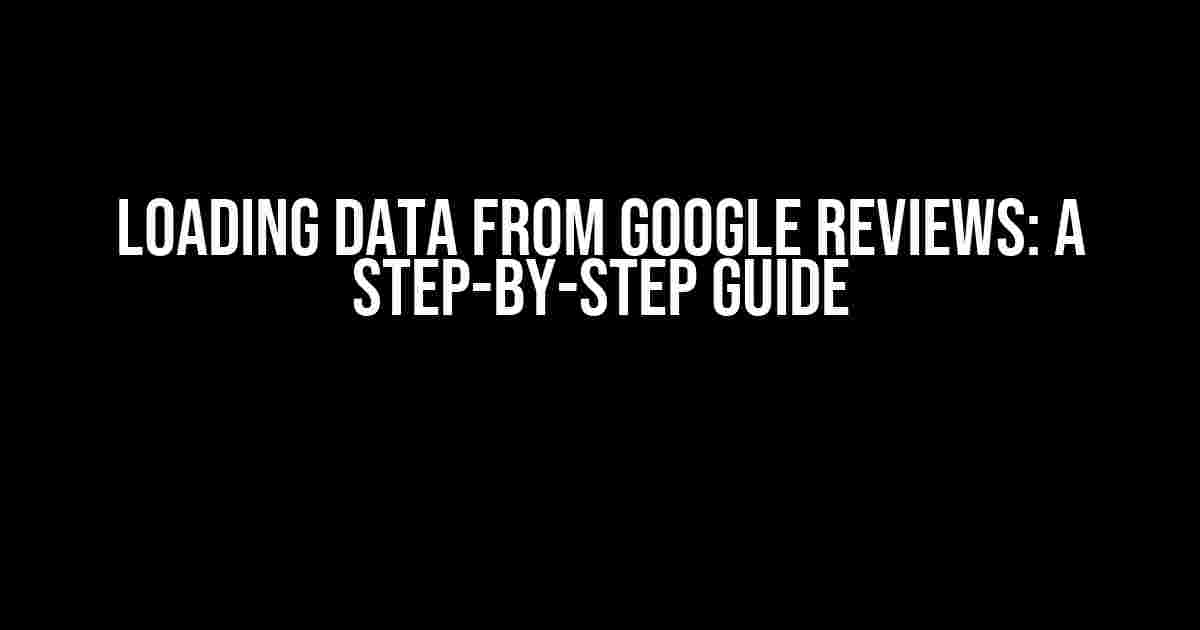Are you tired of manually collecting data from Google Reviews? Do you need a more efficient way to gather insights from customer feedback? Look no further! In this article, we’ll show you how to load data from Google Reviews using programming languages like Python and APIs. Buckle up, because we’re about to dive into the world of web scraping and data analysis!
Why Load Data from Google Reviews?
Google Reviews is an invaluable resource for businesses, providing a wealth of information about customer experiences and opinions. By loading data from Google Reviews, you can:
- Gain insights into customer sentiment and feedback
- Analyze ratings and reviews to identify trends and areas for improvement
- Monitor competitors and stay ahead of the competition
- Implement data-driven decision-making to enhance customer experiences
Method 1: Using Google’s Places API
The Google Places API is a powerful tool for accessing location-based data, including reviews. To get started, you’ll need:
- A Google Cloud account
- A project created in the Google Cloud Console
- Enabled billing for your project
- The Places API enabled in the API Library
Once you’ve set up your project, you can use the Places API to retrieve reviews for a specific location. Here’s an example using Python:
import requests
api_key = "YOUR_API_KEY"
place_id = "ChIJj61dQgmc2EcRmrV3O1pLQHw"
url = f"https://maps.googleapis.com/maps/api/place/details/json?placeid={place_id}&key={api_key}"
response = requests.get(url)
data = response.json()
reviews = data["result"]["reviews"]
for review in reviews:
print(review["text"])
This code snippet retrieves the reviews for a specific place ID and prints the review text to the console. You can modify the code to suit your needs, such as storing the data in a database or performing sentiment analysis.
Method 2: Web Scraping using Python and BeautifulSoup
Web scraping is another approach to loading data from Google Reviews. This method involves parsing HTML content to extract the desired information. For this example, we’ll use Python and the BeautifulSoup library:
import requests
from bs4 import BeautifulSoup
url = "https://www.google.com/maps/place/Googleplex/@37.422/-122.084,15z/data=!4m5!3m4!1s0x808fbc3a9594d93f:0x3a1351a333c0f7b4!8m2!3d37.422!4d-122.084"
response = requests.get(url)
soup = BeautifulSoup(response.content, "html.parser")
reviews = soup.find_all("div", {"class": "review-card"})
for review in reviews:
rating = review.find("span", {"class": "rating"}).text
text = review.find("span", {"class": "review-text"}).text
print(f"Rating: {rating}, Review: {text}")
This code snippet fetches the HTML content of a Google Reviews page, parses it using BeautifulSoup, and extracts the review ratings and texts. You can modify the code to handle pagination, extract more data, or store the results in a database.
Method 3: Using Third-Party APIs and Libraries
If you don’t want to build your own solution from scratch, you can use third-party APIs and libraries that provide access to Google Reviews data. Some popular options include:
- SerpApi: A Google Reviews API that provides a simple and easy-to-use interface
- ReviewTrackers: A review management platform that offers a Google Reviews API
- ScrapeStorm: A web scraping platform that provides a Google Reviews API
These APIs often provide a more straightforward way to access Google Reviews data, but be sure to review their terms of service and pricing models before getting started.
Challenges and Considerations
Loading data from Google Reviews comes with some challenges and considerations:
| Challenge | Description |
|---|---|
| Rate Limiting | Google has rate limits in place to prevent abuse. You’ll need to handle these limits to avoid getting blocked. |
| HTML Structure Changes | Google’s HTML structure can change over time, breaking your web scraping script. Stay vigilant and adapt to changes. |
| Data Quality | Reviews may contain irrelevant or low-quality data. Implement filtering and cleaning processes to ensure high-quality data. |
| Terms of Service | Be sure to review Google’s Terms of Service and comply with their policies to avoid getting banned. |
By understanding these challenges and considerations, you can build a robust and efficient system for loading data from Google Reviews.
Conclusion
Loading data from Google Reviews can be a game-changer for businesses and individuals looking to gain insights from customer feedback. By using the methods outlined in this article, you can access a wealth of information and make data-driven decisions to enhance customer experiences. Remember to stay compliant with Google’s Terms of Service and adapt to changes in their HTML structure and rate limits.
Now it’s your turn! Get started with loading data from Google Reviews and unlock the power of customer feedback. Happy coding!
Frequently Asked Question
Loading data from Google Reviews can be a game-changer for your business. But, you may have some questions about how it works. We’ve got you covered!
What kind of data can I load from Google Reviews?
You can load a treasure trove of data, including reviewer names, ratings, review texts, dates, and even business responses! This data can help you track your online reputation, identify trends, and make data-driven decisions to improve your business.
How do I load data from Google Reviews?
You can use Google’s Review API, web scraping tools, or third-party services that specialize in loading review data. Depending on your technical expertise and needs, you can choose the method that best fits your business goals.
Is it legal to load data from Google Reviews?
Yes, it is legal to load data from Google Reviews, as long as you comply with Google’s terms of service and review policies. Make sure to check their guidelines and respect user privacy and intellectual property rights.
How often should I load data from Google Reviews?
The frequency of loading data depends on your business needs and review volume. If you have a high-volume business, you may want to load data daily or weekly to stay on top of reviews. For lower-volume businesses, monthly or quarterly loading may be sufficient.
What can I do with the loaded data from Google Reviews?
The possibilities are endless! You can analyze sentiment, identify trends, track your online reputation, respond to reviews, and even integrate the data into your CRM or marketing automation tools. Get creative and turn those reviews into valuable business insights!

